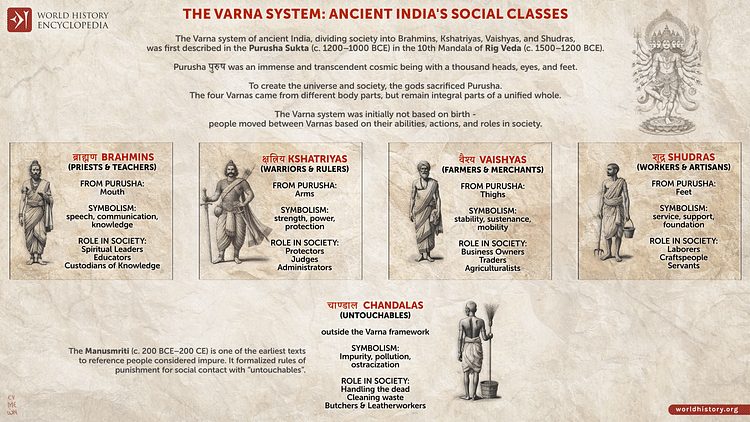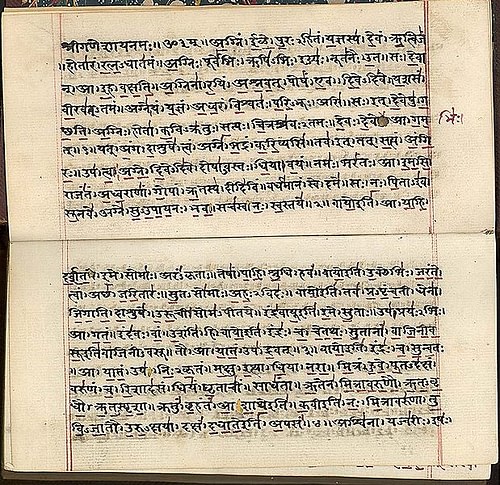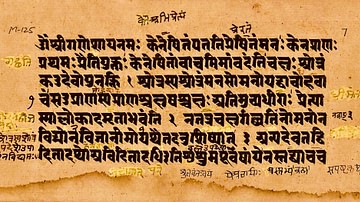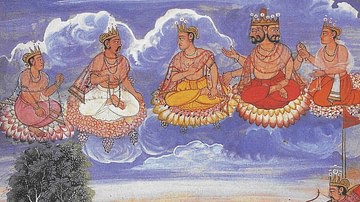Ancient India in the Vedic Period (c. 1500-1000 BCE) did not have social stratification based on socio-economic indicators; rather, citizens were classified according to their Varna or castes. 'Varna' defines the hereditary roots of a newborn, it indicates the colour, type, order or class of people. Four principal categories are defined: Brahmins (priests, gurus, etc.), Kshatriyas (warriors, kings, administrators, etc.), Vaishyas (agriculturalists, traders, etc., also called Vysyas), and Shudras (labourers). Each Varna propounds specific life principles to follow; newborns are required to follow the customs, rules, conduct, and beliefs fundamental to their respective Varnas.

The first mention of Varna is found in the Purusha Suktam verse of the ancient Sanskrit Rig Veda. Purusha is the primordial being, constituted by the combination of the four Varnas. Brahmins constitute its mouth, Kshatriyas its arms, Vaishyas its thighs, and Shudras its feet. Likewise, a society, too, is constituted by these four Varnas, who, through their obedience to the Varna rules, are provisioned to sustain prosperity and order. A newborn in a specific Varna is not mandatorily required to obey its life principles; individual interests and personal inclinations are attended upon with equal solemnity, so as to uproot the conflict between personal choice and customary rules. Given this liberty, a deviated choice is always assessed for its cascading impact on others. The rights of each Varna citizen are always equated with their individual responsibilities. An elaborated Varna system with insights and reasoning is found in the Manu Smriti (an ancient legal text from the Vedic Period), and later in various Dharma Shastras. Varnas, in principle, are not lineages, considered as pure and indisputable, but categories, thus inferring the precedence of conduct in determining a Varna instead of birth.
Purpose of the VARNA System
The caste system in ancient India had been executed and acknowledged during, and ever since, the Vedic period that thrived around 1500-1000 BCE. The segregation of people based on their Varna was intended to decongest the responsibilities of one's life, preserve the purity of a caste, and establish eternal order. This would pre-resolve and avoid all forms of disputes originating from conflicts within business and encroachment on respective duties. In this system, specific tasks are designated to each Varna citizen. A Brahmin behaving as a Kshatriya or a Vaishya debases himself, becoming unworthy of seeking liberation or moksha. For a Brahmin (having become one by deed, in addition to the one by birth) is considered the society's mouth, and is the purest life form as per the Vedas, because he personifies renunciation, austerity, piousness, striving only for wisdom and cultivated intellect. A Kshatriya, too, is required to remain loyal to his Varna duty; if he fails, he could be outcast. The same applies to Vaishyas and Shudras. Shudras, far from left out or irrelevant, are the base of an economy, a strong support system of a prosperous economic system, provided they remain confined to their life duties and not give in to greed, immoral conduct, and excess self-indulgence.
The main idea is that such order in a society would lead to contentment, perpetual peace, wilful adherence to law, wilful deterrence from all misconduct, responsible exercise of liberty and freedom, and keeping the fundamental societal trait of 'shared prosperity' above all others. Practical and moral education of all Varnas and such order seemed justified in ancient Indian society owing to different Varnas living together and the possibility of disunity among them. Hence, Brahmins were entrusted with the duty of educating pupils of all Varnas to understand and practice order and mutual harmony, regardless of distressed circumstances. Justice, moral, and righteous behaviour were primary teachings in Brahmins' ashrams (spiritual retreats, places to seek knowledge). Equipping pupils with a pure conscience to lead a noble life was considered essential and so was practical education to all Varnas, which provided students with their life purposes and knowledge of right conduct, which would manifest later into an orderly society.
The underlying reason for adhering to Varna duties is the belief in the attainment of moksha on being dutiful. Belief in the concept of Karma reinforces the belief in the Varna life principles. As per the Vedas, it is the ideal duty of a human to seek freedom from subsequent birth and death and rid oneself of the transmigration of the soul, and this is possible when one follows the duties and principles of one's respective Varna. According to the Vedas, consistent encroachment on others' life responsibilities engenders an unstable society. Brahmins, Kshatriyas, Vaishyas, and Shudras form the fourfold nature of society, each assigned appropriate life duties and ideal disposition. Men of the first three hierarchical castes are called the twice-born; first, born of their parents, and second, of their guru after the sacred thread initiation they wear over their shoulders. The Varna system is seemingly embryonic in the Vedas, later elaborated and amended in the Upanishads and Dharma Shastras.

Brahmins
Brahmins were revered as an incarnation of knowledge itself, endowed with the precepts and sermons to be discharged to all Varnas of society. They were not just revered because of their Brahmin birth but also their renunciation of worldly life and cultivation of divine qualities, assumed to be always engrossed in the contemplation of Brahman, hence called Brahmins. Priests, gurus, rishis, teachers, and scholars constituted the Brahmin community. They would always live through the Brahmacharya (celibacy) vow ordained for them. Even married Brahmins were called Brahmachari (celibate) by virtue of having intercourse only for reproducing and remaining mentally detached from the act. However, anyone from other Varnas could also become a Brahmin after extensive acquisition of knowledge and cultivation of one's intellect.
Brahmins were the foremost choice as tutors for the newborn because they represent the link between sublime knowledge of the gods and the four Varnas. This way, since the ancestral wisdom is sustained through guru-disciple practice, all citizens born in each Varna would remain rooted to the requirements of their lives. Normally, Brahmins were the personification of contentment and dispellers of ignorance, leading all seekers to the zenith of supreme knowledge, however, under exceptions, they lived as warriors, traders, or agriculturists in severe adversity. The ones bestowed with the titles of Brahma Rishi or Maha Rishi were requested to counsel kings and their kingdoms' administration. All Brahmin men were allowed to marry women of the first three Varnas, whereas marrying a Shudra woman would, marginally, bereft the Brahmin of his priestly status. Nevertheless, a Shudra woman would not be rejected if the Brahmin consented.

Brahmin women, contrary to the popular belief of their subordination to their husbands, were, in fact, more revered for their chastity and treated with unequalled respect. As per Manu Smriti, a Brahmin woman must only marry a Brahmin and no other, but she remains free to choose the man. She, under rare circumstances, is allowed to marry a Kshatriya or a Vaishya, but marrying a Shudra man is restricted. The restrictions in inter-caste marriages are to avoid subsequent impurity of progeny born of the matches. A man of a particular caste marrying a woman of a higher caste is considered an imperfect match, culminating in ignoble offspring.
Kshatriyas
Kshatriyas constituted the warrior clan, the kings, rulers of territories, administrators, etc. It was paramount for a Kshatriya to be learned in weaponry, warfare, penance, austerity, administration, moral conduct, justice, and ruling. All Kshatriyas would be sent to a Brahmin's ashram from an early age until they became wholly equipped with requisite knowledge. Besides austerities like the Brahmins, they would gain additional knowledge of administration. Their fundamental duty was to protect their territory, defend against attacks, deliver justice, govern virtuously, and extend peace and happiness to all their subjects, and they would take counsel in matters of territorial sovereignty and ethical dilemmas from their Brahmin gurus. They were allowed to marry a woman of all Varnas with mutual consent. Although a Kshatriya or a Brahmin woman would be the first choice, Shudra women were not barred from marrying a Kshatriya.
Kshatriya women, like their male counterparts, were equipped with masculine disciplines, fully acquainted with warfare, rights to discharge duties in the king's absence, and versed in the affairs of the kingdom. Contrary to popular belief, a Kshatriya woman was equally capable of defending a kingdom in times of distress and imparting warfare skills to her descendants. The lineage of a Kshatriya king was kept pure to ensure continuity on the throne and claim sovereignty over territories.
Vaishyas
Vaishya is the third Varna represented by agriculturalists, traders, money lenders, and those involved in commerce. Vaishyas are also the twice-born and go to the Brahmins' ashram to learn the rules of a virtuous life and to refrain from intentional or accidental misconduct. Cattle rearing was one of the most esteemed occupations of the Vaishyas, as the possession and quality of a kingdom's cows, elephants, horses, and their upkeep affected the quality of life and the associated prosperity of the citizens. Vaishyas would work in close coordination with the administrators of the kingdom to discuss, implement, and constantly upgrade the living standards by providing profitable economic prospects. Because their life conduct exposes them to objects of immediate gratification, their tendency to overlook the law and despise the weak is perceived as probable. Hence, the Kshatriya king would be most busy with resolving disputes originating of conflicts among Vaishyas.

Vaishya women, too, supported their husbands in business, cattle rearing, and agriculture, and shared the burden of work. They were equally free to choose a spouse of their choice from the four Varnas, albeit selecting a Shudra was earnestly resisted. Vaishya women enjoyed protection under the law, and remarriage was undoubtedly normal, just as in the other three Varnas. A Vaishya woman had equal rights over ancestral properties in case of the untimely death of her husband, and she would be equally liable for the upbringing of her children with support from her husband.
Shudras
The last Varna represents the backbone of a prosperous economy, in which they are revered for their dutiful conduct toward life duties set out for them. Scholarly views on Shudras are the most varied since there seemingly are more restrictions on their conduct. However, Atharva Veda allows Shudras to hear and learn the Vedas by heart, and the Mahabharata, too, supports the inclusion of Shudras in ashrams and their learning the Vedas. Becoming officiating priests in sacrifices organised by kings was, however, to a large extent restricted. Shudras are not the twice-born, hence not required to wear the sacred thread like the other Varnas. A Shudra man was only allowed to marry a Shudra woman, but a Shudra woman was allowed to marry from any of the four Varnas.
Shudras would serve the Brahmins in their ashrams, Kshatriyas in their palaces and princely camps, and Vaishyas in their commercial activities. Although they are the feet of the primordial being, learned citizens of higher Varnas would always regard them as a crucial segment of society, for an orderly society would be easily compromised if the feet are weak. Shudras, on the other hand, obeyed the orders of their masters, because their knowledge of attaining moksha by embracing their prescribed duties encouraged them to remain loyal. Shudra women, too, worked as attendants and close companions of the queen and would go with her after marriage to other kingdoms. Many Shudras were also allowed to be agriculturalists, traders, and enter occupations of Vaishyas. These detours of life duties would, however, be under special circumstances, on perceiving deteriorating economic situations. The Shudras' selflessness makes them worthy of unprecedented regard and respect.
Gradual withdrawal from the ancient Varna duties
Despite the life order being arranged for all kinds of people, by the end of the Vedic period, many began to deflect and disobey their primary duties. Brahmins started to feel the authoritarian nature of their occupation and status, because of which arrogance seeped in. Many gurus, citing their advice-imparting position to Kshatriya kings, became unholy and deceitful by practising Shudra qualities. Although Brahmins are required only to live on alms and not seek more than their minimal subsistence, capitalising on their superior status and unquestioned hierarchical outreach, they began to demand more for conducting sacrifices.
Kshatriyas contested with other kings often to display their prowess and possessions. Many kings found it acceptable to reject their Brahmin guru's advice and hence became self-regulating, taking unrighteous decisions, leading to loss of kingship, territory, and the confidence of the Vaishyas and Shudras. Vaishyas started to see themselves as powerful in their ownership of land and subjection of Shudras. Infighting, deceit, cheating influenced the conduct of Vaishyas. Shudras were repeatedly oppressed by the Kshatriyas and Vaishyas at will, which made them disown their duties and instead opt for stealing, lying, avariciousness, and spreading misinformation.
Thus, all Varnas fell from their virtuosity, and unrighteous acts of one continued to inspire and justify similar acts of others. Mixing of castes was also considered a part of the declining interest in Varna system. Most of these changes took place between 1000 BCE and 500 BCE when constant social and economic complexities emerged as new challenges for Varna-based allocation of duties. Population increased, and so did the disunity of citizens in their collective belief in the sanctity of the original Varna system. Religious conversions played a significant part in subsuming large societies into the tenets of humanism and a single large society.
The period between 300 CE to 700 CE marked the intersection of multiple religions. As a large Varna populace became difficult to handle, the emergence of Jainism propounded the ideology of one single human Varna and nothing besides. Many followed the original Varna rules, but many others, disapproving opposing beliefs, formed modified sub-Varnas within the primary four Varnas. This process, occurring between 700 CE and 1500 CE, continues to this day, as India is now home to a repository of the primary four Varnas and hundreds of sub-Varnas, making the original four Varnas merely 'umbrella terms' and perpetually ambiguous.
The subsequent rise of Islam, Christianity, and other religions also left their mark on the original Varna system in India. Converted generations reformed their notion of Hinduism in ways that were compatible with the conditions of those times. The rise of Buddhism, too, left its significant footprint on the Varna system's legitimate continuance in renewed conditions of life. Thus, soulful adherence to Varna duties from the peak of Vedic period eventually diminished to subjective makeshift adherence, owing partly to the discomfort in practising Varna duties and partly to external influence.
While the above impacts were gradual, expeditious withdrawal from Varna rules was made possible by the large-scale influence of western notions of liberty, equality, and freedom. These changes can be observed from 1500 CE right through the present. For Western nations, rooted in their own cultural background, it made little sense to approve of this in their eyes antiquated Varna system. Intercepting the Moghul invasion and the near-end sovereignty of multiple Hindu dynasties, British invasion brought with it a fresh worldview based on equality and freedom, incompatible with the Varna system. Massive colonisation, impact of 'cultural imperialism' enforced significant alterations on Varna duties. Trade and liberalisation, exchange of culture dented the tiny bit of belief left in continuing the Varna system.
Despite this perpetual decline, the descendants of all four Varnas in contemporary India are trying to reinvent their roots in search of ancestral wisdom. Although the four Varnas have encroached upon each other's life duties, a sense of order and peace is sought and recalled in discourses, community gatherings, and engagement between different generations. Varna system in contemporary terms is followed either with earnest commitment without reservations and doubt or with ambiguity and resistance arising out of unprecedented external influence and issues of subjective incompatibility. While many citizens practice a diluted version of Varna system, extending its limitations and rigidness to a broader context of Hindu religion, staunch believers still strive and promote the importance of reclaiming the system.





